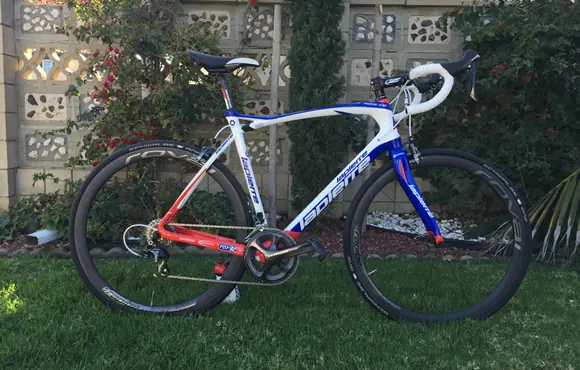The new Pulsium 500 by Lapierre, made with a radical frame designed to absorb more shock, seeks to solve this problem without sacrificing performance.
Here's how our tests rank the Pulsium 500 against other endurance road bikes in its class.
Specifications
1 of 11
Cost: $3,499
Weight: 17.1 pounds
Frame: Pulsium Carbon
Components: Shimano Ultegra
Wheels: Mavic Aksium S WTS (pictured with Specialized Roval CLX40, $2,000)
Tires: Mavic Aksion 25
Handlebar/Stem: Zipp Service Course 80 Anatomic
Seat post: Lapierre Carbon
The Frame
2 of 11
The first thing you'll notice about the Pulsium's design is the funky looking top tube. The frame splits just before the junction of the seat tube with the bottom section acting as an elastomer damper for road vibration.
The Frame (Continued)
3 of 11
This technology, known as SAT (Shock Absorption Technology), claims to provide 27 percent more vertical compliance than the Sensium, which is Lapierre's other endurance road bike. This means that energy transfer from your pedal stroke through the frame won't be compromised in the name of comfort—making it a reasonable option for serious racers and weekend warriors alike.
The Frame (Continued)
4 of 11
While most cyclists will love or hate the aesthetics, we found the design to provide an extremely comfortable ride over even the roughest of roads. In addition to the curved top tube, the rear seat stays and offset front fork (50 degrees) make for a plush ride that you'll come to appreciate after a few hours in the saddle.
The Components
5 of 11
The 500 is the mid range in the Pulsium lineup (the 300 and the 700 are the lower and higher-end models). While the major differences in the frame are the types of carbon used, the majority of the price difference in the higher and lower models is the components package. The mid-level Ultegra is the bargain-buy in Shimano's lineup. While not as light as Dura Ace, it's a solid group that is built to last and performs at a high level. Shifting is precise and the braking power is some of the best you'll find in any group set.
Fizik Saddle and Zipp Front End
6 of 11
Along with the Ultegra package, Lapierre completes the bike with Mavic Aksium wheels, a Fizik Aliante saddle and the aluminum Zipp Service Course handlebar and stem. The front-end package and saddle choice are a good fit for the Pulsium; they aren't the lightest, but they are both quality options that are made with ergonomics and comfort as a top priority.
The Wheels
7 of 11
The only upgrade needed is in the wheel selection. While the Mavic Aksium is a good training wheel that you might want to save for bad weather riding, it's an entry-level option that doesn't fit with the rest of the build. An upgrade here (bike pictured with the Specialized Roval CLX 40 wheelset) would make the Pulsium 500 suitable for almost any type of racing other than criteriums.
The Ride
8 of 11
Endurance bikes with shock-dampening capabilities aren't new to the bike industry. The Trek Domane, the Cannondale Synapse and the Specialized Roubaix are a few others that come to mind. While the Trek Domane has the most noticeable bounce—similar to what you might feel with a mountain bike or cyclocross shock—what takes the Pulsium to the next level is its ability to accelerate and performance on climbs, which are top shelf for an endurance category road bike.
You'll also notice that the Pulsium is an extremely quiet bike, particularly over rough surfaces such as gravel, dirt or really rough sections of road. You won't get any vibration or noisy chattering that's common with almost every other bike on the market.
The Ride (Continued)
9 of 11
The 72.5-degree angles and long top tube of the frame give the bike a racing geometry, while the tall head tube situates the rider in a slightly more upright position that improves comfort in the back and shoulders for long-distance cycling. This combination makes it easy to control around sharp corners and on long, fast descents. The long wheel base of the Pulsium also stabilizes the bike, giving you the extra confidence you sometimes need to reach for higher speeds.
The Verdict
10 of 11
The Pulsium 500 is slightly slower and little heavier than your standard top-of-the-line race bike. The Pulsium makes up for these deficiencies by creating a bike that's meant to tackle rough roads and long miles. But that doesn't mean the Pulsium isn't race ready. The FDJ team will use the Pulsium in this year's Paris Roubaix, which features some of the roughest terrain you'll see in any of the European Classics—a testament to the bike's overall comfort and performance abilities.
If you're looking for a bike that you can train and race on, the Pulsium 500 might be the best in the endurance category that we've tested. It can climb, corner, and descend with some of the best bikes on the market. The price isn't cheap at $3,499, but it isn't near the $10,000 dollar range of high-end models either. A good wheel set will likely set you back another $1,000 or more. The end result will be a bicycle that's fun to ride almost anywhere you decide to go.
Overall Rating: 4.5/5







Discuss This Article